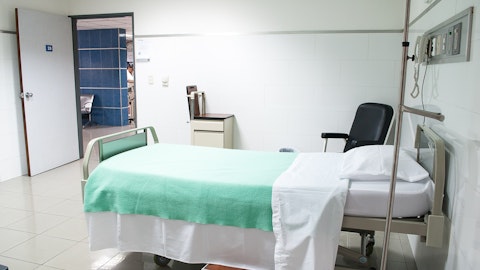MetLife, Inc. (NYSE:MET) Q2 2023 Earnings Call Transcript August 3, 2023
Operator: Ladies and gentlemen, thank you for standing by. Welcome to the MetLife Second Quarter 2023 Earnings Conference Call. At this time, all participants are in a listen-only mode. Later, we will conduct a question-and-answer session, instructions will be given at that time. As a reminder, this conference is being recorded. Before we get started, I refer you to the cautionary note about forward-looking statements in yesterday’s earnings release and to risk factors discussed in MetLife’s SEC filings. With that, I will turn the call over to John Hall, Global Head of Investor Relations.
John Hall: Thank you operator. Good morning everyone. We appreciate you joining us for MetLife’s second quarter 2022 earnings call. Before we begin, I’d point you to the information on non-GAAP measures on the Investor Relations portion of MetLife.com, in our earnings release and in our quarterly financial supplements, which you should review. On the call this morning are Michel Khalaf, President and Chief Executive Officer; and John McCallion, Chief Financial Officer. Also participating in the discussion are other members of senior management. Last night, we released a set of supplemental slides, which address the quarter. The slides are available on our website. John McCallion will speak to them in his prepared remarks if you wish to follow along.

Pixabay/Public Domain
An appendix to the slides features disclosures, GAAP reconciliations, and other information, which you should similarly review. As usual, after prepared remarks, we will host the Q&A session, which will end promptly just prior to the top of the hour. In fairness to everyone, please limit yourself to one question and one follow-up. With that, over to Michelle.
Michel Khalaf: Thank you, John, and good morning, everyone. As market conditions continue to fluctuate, what has been a constant is the underlying performance of MetLife’s diversified set of market-leading businesses. What has also been constant is the relentless execution of our strategy, which includes delivering in the second quarter on our commitment to accelerate the runoff of our legacy business through a financially attractive deal that also reduces enterprise risk. Our strong risk management capabilities are the bedrock of MetLife. This foundation enables us to successfully navigate shifting currents. We are confident in the prudence of our investment portfolio. We are secure in the effectiveness of our asset liability matching.
We are certain of the safety and soundness of our capital and liquidity, and we are convinced of our balance sheet’s strength. Shifting to second quarter results, last night we reported adjusted earnings of $1.5 billion, or $1.94 per share, which compares to $1.7 billion, or $2.13 per share a year ago. We continue to be pleased with the underlying momentum of our core businesses, which was evident in the quarter. Our sales were strong across the board with impressive results in group, retirement and income solutions, Asia and Latin America. Our underwriting results were well within targeted levels. Our direct expense ratio totaled 12.2%, illustrating our capacity to generate further operating leverage. Our recurring investment income continues to climb with new money rates pushing past 6%, and our adjusted return on equity of 14.6%, excluding AOCI other than FCTA, met our target range of 13% to 15%.
For the quarter, variable investment income of $221 million came in below our outlook expectation. In the aggregate, private equity returns were about 1.5%, inclusive of a positive 40 basis point return on our venture capital portfolio. We generated a minus 1.9% return on real estate equity funds, an asset class that remains under some cyclical pressure. Nonetheless, we believe we’ve reached the trough relative to VIIs contribution to our quarterly adjusted earnings. In total, net income for the second quarter was $370 million, which reflects certain required accounting adjustments following the announcement of our pending re-insurance transaction with Global Atlantic. We did not incur material credit losses in our real estate portfolio or elsewhere during the second quarter.
Shifting to MetLife’s business performance in the quarter, I will start with our US group benefits results. Adjusted earnings totaled $372 million with underwriting results in line with our expectations after reflecting certain unfavorable items. In total, year-to-date sales are up 13% while year-to-date adjusted PFOs are up 5%, reflecting the impact of par firmly within our 4% to 6% outlook range, which we expect to achieve for the full year 2023. Looking ahead, we are confident in our ability to sustain our growth trajectory in this attractive capital-light business for many reasons. The strength of our relationships with our largest national accounts, where our average customer has been with us for more than 20 years, is well-known. The power behind this strength is apparent when you consider that 75% of new sales are made to existing customers through product additions and enrollment growth.
Our efforts to accelerate growth in regional business is evident in our market share gains. A key element of this success is driven by our expansive product portfolio, the broadest across the benefits universe. As a proof point, more than half of our new regional business customers purchase multiple products. And again, this can also be seen in our success with voluntary products, which we’ve been able to grow at a mid-to-high-teens rate for many years now. For retirement and income solutions, or RIS, adjusted earnings totaled $417 million, up 11% from the prior year, driven by higher recurring investment margins and higher asset balances. Sales in the quarter were very strong across a range of products, including pension risk transfer with more than $2 billion booked, structured settlements, longevity reinsurance, and post-retirement benefits.
We see good run rates for growth in all these areas. In Asia, adjusted earnings of $431 million were below a year ago on lower variable investment income. Our ability to bring new products quickly to market was on full display in the quarter. Sales on a constant currency basis were up 34% in the region, led by Japan, where sales jumped 42% year-over-year, led by the introduction of a foreign currency life insurance product. Turning to Latin America, which put up another strong quarter, adjusted earnings totaled $219 million. Further, Latin America posted gains in both sales and adjusted PFOs of 13% and 14% respectively on a constant currency basis. Taking a wider lens on the momentum in our business, we managed through the pandemic expecting to emerge from the turmoil stronger than we entered.
With the fullness of time, we can now see that is true. Some numbers can help. In full year 2019, our group benefits business generated premiums, fees, and other revenues of roughly $19 billion. We are on track to generate group benefits PFOs of roughly $24 billion in 2023, representing $5 billion of growth at a CAGR of more than 5%. In 2019, our retirement income solutions business generated average quarterly adjusted earnings of $310 million, with variable investment income matching outlook expectations. So far in 2023, RIS has averaged about $410 million of adjusted earnings per quarter, without the benefit of normal VII. Similarly, our Latin America business averaged roughly $150 million of adjusted earnings per quarter in 2019, which has grown to an average of more than $200 million per quarter in 2023.
To me, the message is clear. The fundamentals associated with our market leading businesses continue to gather steam. Moving to capital and cash, MetLife remained active with capital management during the second quarter. Following the increase to our common stock dividend, we paid roughly $400 million of common stock dividends to shareholders, and we repurchased $672 million of our common stock. The pace of repurchases in the second quarter slowed due to the impending announcement of our reinsurance deal. In addition to our activity in the second quarter, we repurchased roughly another $300 million of our common stock during the month of July. Here today through July, we have repurchased about $1.8 billion of our common shares, which leaves approximately $3.5 billion remaining on our expanded repurchase authorization.
As we have done consistently over time, we carefully assess every use of capital with the goal of achieving the right balance between investing in responsible growth for the future and returning capital to generate sustainable long-term value for our shareholders. At the end of the quarter, we held $4.2 billion of cash at our holding companies, which is above the top end of the $3 billion to $4 billion liquidity buffer we maintained. In the beginning of July, we issued $1 billion of senior debt on attractive terms, which will be included in our cash balance in the third quarter. Beyond this, the dynamics of our reinsurance transaction will further add to cash as we move through the remainder of this year. During the quarter, we announced that Steve Goulart will retire at the end of August.
Today will be his last earnings call with us. So feel free to pepper him with questions. You will not get another chance. I would like to take this moment to thank Steve for his 17 years of distinguished service to MetLife. In that time span, he led our corporate development and mergers and acquisitions team and served as treasurer before taking on his roles as MetLife’s chief investment officer and the president of MetLife Investment Management. From a standing start in 2012, Steve established MetLife Investment Management and fostered its growth to its present status as a $167 billion institutional fixed income and real estate manager. I believe the talent at MetLife truly sets us apart and serves as a clear differentiator for our company.
Steve’s retirement provides the opportunity to broaden the roles and responsibilities of some of our top leaders. In addition to her role as chief risk officer, Marlene Debel will lead MetLife Insurance Investments with chief investment officer Chuck Scully reporting directly to Marlene. John McCallion, MetLife’s chief financial officer will take on additional responsibility as the head of MetLife Investment Management. And Ramy Tadros, regional president to us business, will add head of MetLife Holdings to his portfolio. These moves draw upon MetLife’s deep bench and illustrate our ability to deploy top talent to the areas of greatest impact for our customers and shareholders. In closing, MetLife’s all weather strategy positions us to perform across a range of economic cycles.
By focusing on what we can control, how we execute, how we invest, and how we deploy capital, we will continue to create long-term value for our shareholders and other stakeholders. Now I’ll turn it over to John to cover our performance in greater detail.
John McCallion: Thank you, Michelle, and good morning. I will start with the 2Q ’23 supplemental slides which provide highlights of our financial performance and an update on our liquidity and capital positions. In addition, I’ll provide an update on our commercial mortgage loan portfolio. Starting on Page three, we provide a comparison of net income to adjusted earnings in the second quarter. Net investment losses were primarily the result of securities that were associated with the pending reinsurance transaction with Global Atlantic that we announced at the end of May. For GAAP purposes, gross unrealized losses as of June 30 on securities expected to be transferred to Global Atlantic at closing are required to be realized through net income this quarter.
In addition, we had net derivative losses due to the favorable equity markets, strengthening of the U.S. dollar versus the Yen, and higher interest rates. That said, derivative losses were mostly offset this quarter by market risk benefit, or MRB remeasurement gains, due to higher equity markets and interest rates. Overall, the portfolio remains well positioned, credit losses continue to be modest, and the hedging program performed as expected. On Page four, you can see the second quarter year-over-year comparison of adjusted earnings by segment, excluding a favorable notable item of $77 million in 2Q of ’22, primarily related to a reinsurance settlement, which was accounted for in MetLife Holdings. There were no notable items in the current quarter.
Adjusted earnings were $1.5 billion down 10%, and down 11% on a constant currency basis. The primary driver was lower variable investment income. Underwriting margins were also less favorable than the prior year, but within our targeted ranges. Higher recurring interest margins and solid volume growth were partial offsets. Adjusted earnings per share were $1.94 down 5% year-over-year on a reported and constant currency basis. Moving to the businesses starting with the U.S., group benefits adjusted earnings were $372 million, down 8% versus the prior year period. Results were below run rate expectations for the quarter due to certain unfavorable expense, reinsurance, and reserve related items, which reduced group benefits adjusted earnings by approximately $40 million, and were specific to this quarter.
The group-life mortality ratio was 85.3%, essentially in line with the prior year quarter, and at the bottom end of our annual target range of 85% to 90%. Regarding non-medical health, the interest adjusted benefit ratio was 73.7% in the quarter, above the midpoint of its annual target range of 70% to 75%. We had a disability reserve refinement of approximately $15 million after tax, which increased the ratio by 0.8 percentage points, and was included in the items totaling $40 million that I just referenced. Turning to the top line, group benefits adjusted PFOs were up 4% year-over-year. Taking participating contracts into account, which dampened growth by roughly 1%, the underlying PFOs were up approximately 5% year-over-year, primarily due to solid growth across most products, including continued strong momentum and voluntary, and was within our 2023 target growth range of 4% to 6%.
In addition, group benefit sales were up 13% year-to-date, driven by strong growth across most products end markets. Retirement and income solutions, or RIS, adjusted earnings were $417 million, up 11% year-over-year. The primary drivers were higher recurring interest margins and solid volume growth. This was partially offset by lower variable investment income year-over-year. RIS investment spreads were 132 basis points. Spreads excluding VII were 142 basis points, up 29 basis points versus Q2 of ’22, primarily due to higher interest rates, as well as income from in the money interest rate caps. RIS liability exposures were up 5% year-over-year, driven by general account liabilities, which grew 7% due to strong net flows. RIS adjusted PFOs excluding pension risk transfers were up 73%, primarily driven by strong sales of structured settlement products and growth in UK longevity reinsurance.
With regards to PRT, we completed two transactions worth approximately $2 billion in the quarter, and continue to see an active market. Moving to Asia, adjusted earnings were $431 million, down 11% and 9% on a constant currency basis, primarily due to lower variable investment income. Adjusted earnings ran approximately $25 million above expectation due to certain reserve refinements and tax related true ups. Asia’s key growth metrics were strong as general account assets under management on an amortized cost basis grew 5% on a constant currency basis, and sales were up 34% year-over-year on a constant currency basis, driven by strong growth across the region. In Japan, sales were up 42% year-over-year, driven by continued strong momentum in FX annuities through our face-to-face channels, as well as life sales due to a relaunch of a single premium FX life product on April 1.
We continue to see Japanese consumer interest for FX products given the attractive higher U.S. interest rates. Latin America adjusted earnings were $219 million, down 13% and 21% on a constant currency basis, due to less favorable underwriting margin versus 2Q of ’22. The prior year quarter had a roughly $40 million benefit to adjusted earnings from a release of a COVID related IB&R reserve. In addition, investment margins were down year-over-year, partially offset by solid volume growth. Latin America’s top line continues to perform well, as adjusted PFOs were up 23% and 14% on a constant currency basis, and sales were up 13% on a constant currency basis, driven by growth across the region. EMEA adjusted earnings were $70 million, up 6% and up 15% on a constant currency basis, primarily driven by higher recurring interest margins.
EMEA adjusted PFOs were up 4% on a constant currency basis, and sales were up 13% on a constant currency basis, reflecting strong growth across the region. MetLife holdings adjusted earnings were $211 million, down 31%. This decline was primarily driven by lower variable investment income. Corporate and other adjusted loss was $228 million, essentially flat versus an adjusted loss of $227 million in the prior year. The company’s effective tax rate on adjusted earnings in the quarter was approximately 22%, and at the low end of our 2023 guidance of 22% to 24%. On Page five, this chart reflects our pre-tax variable investment income for the prior five quarters, including $221 million in Q2 of ‘23. Private equity portfolio, $14.6 billion, had a plus 1.5% return in the quarter.
Real estate equity funds of $2.2 billion had a minus 1.9% return, while both PE and real estate equity funds are reported on a one quarter lag. As of now, we anticipate that VII in the third quarter will generally be in line with the second quarter result. On Page six, we provide VII post tax by segment for the prior five quarters. As you’ve noted previously, each of the businesses holds its own discrete investment portfolios, which have been built to match its liabilities. As reflected in the chart, Asia, RAS, and MetLife Holdings continue to hold the largest portion of VII assets given their long dated liability profile. For 2Q of ‘23, Asia’s VII portfolio generated the highest returns at 2.2%, outperforming MetLife Holdings at 1.5% and RAS at 0.9%.
Now turning to Page seven, the chart on the left of the Page shows the split of our net investment income between recurring and VII for the past three years in Q2 of ‘22 versus Q2 of ‘23. While VII has had the lower than trend returns over the last few quarters, recurring income, which accounts for approximately 96% of net investment income, was up $700 million year-over-year, reflecting higher interest rates and growth in asset balances. Shifting your attention to the chart on the right of the Page, which shows our new money yield versus roll off yield over the past three years, new money yields continue to outpace roll off yields in the recent quarters. In this quarter, our global new money yield reached its highest level in more than a decade of 6.06%, 157 basis points higher than the roll off yield.
We expect this favorable trend to continue assuming interest rates remain near current levels. Turning to Page eight, I’ll provide a few updates on our commercial mortgage loans, which you can find further details in our quarterly financial supplement. As of June 30, our commercial mortgage loan, or CML portfolio, carrying value of approximately $53 billion is well diversified by geography and property type. The CML portfolio is concentrated in high quality properties and in larger primary markets. These loans are typically to the larger and stronger institutional sponsors who are better positioned to effectively manage assets through periods of stress. Given the focus on the office sector, our real estate team updated all U.S. office valuation through June 30, assuming a 25% peak to trough valuation decline.
We believe it was prudent to focus our efforts here in the quarter given the heightened attention this has received. As expected, LTVs increased slightly as a result with our CML portfolio now in an average LTV of 62%, up from 58% in the first quarter of ‘23, and an average debt service coverage ratio of 2.3 times down slightly from 2.4 times in 1Q ‘23. The modest increase in LTVs coupled with the resiliency and robustness of the debt service coverage ratio is another indicator of the disciplined approach we take to investing in this asset class. The quality of our CML portfolio remains strong with only 2% of the loans having LTVs more than 80% and DSCRs less than one times. With regards to CML loan maturities, we now have successfully resolved 69% of the portfolio’s schedule to mature in 2023, and our expectation is for minimal losses on the portfolio.
Now let’s switch gears to discuss expenses on Page 9. This chart shows a comparison of our direct expense ratio for full year 2022, as well as Q1 of ’23 and Q2 of ’23, which had a ratio of 12.2%. As you have highlighted previously, we believe our full year direct expense ratio is the best way to measure performance due to fluctuations in quarterly results. Our Q2 direct expense ratio benefited from solid top-line growth and ongoing expense discipline. We remain committed to achieving a full year direct expense ratio of 12.6% or below in 2023, demonstrating our consistent execution and focus on an efficiency mindset. I will now discuss our cash and capital positions on Page 10. Cash and liquid assets at the holding companies were approximately $4.2 billion at June 30, which is above our target cash buffer of $3 to $4 billion and consistent with March 31.
The cash at the holding companies reflects the net effects of subsidiary dividends, payment of our common stock dividend, and share repurchases of roughly $700 million in the second quarter, as well as holding company expenses and other cash flows. The buybacks in Q2 of ’23 were lower than our recent trend as we were in a blackout period for most of May in advance of our pending reinsurance transaction with Global Atlantic. That said, we have repurchased shares totaling approximately $300 million in July. For our U.S. companies, preliminary second quarter, year-to-date 2023 statutory operating earnings were approximately $2 billion, while net income was approximately $1.3 billion, statutory operating earnings increased by approximately $1.3 billion year-over-year, primarily driven by favorable underwriting, partially offset by higher expenses.
We estimate that our total U.S. statutory adjusted capital was approximately $17.4 billion as of June 30, 2023, down 2% from March 31, 2023, primarily due to the temporary impact of roughly $300 million associated with the investments expected to be transferred to Global Atlantic. We expect these impacts to reverse at close, which remains on target by year-end. In addition, as previously disclosed, we expect the transaction to add approximately 60 combined RBC points. Finally, we expect the Japan-Solvency Margin Ratio to be approximately 700% as of June 30, which will be based on statutory statements that will be filed in the next few weeks. Let me conclude with a few points. First, while VII remains below historical returns, we believe we reached a trough.
In addition, core spreads remain robust and continue to benefit from a higher yielding environment. Second, the underlying strength of our business fundamentals continues to be displayed with strong top-line growth coupled with disciplined underwriting and expense management. Lastly, MetLife remains in a position of strength, given our balance sheet, investment portfolio, free cash flow generation, and the diversification of our market-leading businesses. And we are committed to deploying capital to achieve responsible growth and building sustainable value for our customers and our shareholders. And with that, I will turn the call back to the operator for your questions.
Operator: Thank you. [Operator Instructions] And we first go to the line of Ryan Krueger with KBW. Please go ahead.
See also 20 Most Educated States in America and 10 Recent IPOs in 2023 to Consider.
Q&A Session
Follow Metlife Inc (NYSE:MET)
Follow Metlife Inc (NYSE:MET)
Ryan Krueger: Hi, thanks. Good morning. My first question was, following the recent risk transfer deal, do you see further opportunities for additional risk transfer in MetLife holdings over time?
John McCallion: Good morning, Ryan. It’s John. I think we would probably follow the same commentary we’ve given before. We are continuing to look for ways to optimize. We look internally for ways to optimize, and we continue to have external communications around different opportunities. I think at the end of the day, similar to what we did with this transaction, it needs to fit the right profile for us. It needs to be value-creative. It needs to be risk-reducing. And by the end of the day, we don’t have to. We’re very comfortable managing these blocks of businesses ourselves. We have the expertise. And I think there are different ways to find ways to optimize that book. But nonetheless, it’s a healthy process for us continuing to have these conversations.
Ryan Krueger: Thanks. And then I had to ask one for Steve on his last call. Could you provide some additional details on the office loans that have been resolved year-to-date, the mix of paydowns versus extensions and any more color on what the terms of the extensions are?
Steven Goulart: Hey, Ryan, thanks for the question. I would hate to go through my last earnings call without a question. But on your question, let me talk about the total portfolio. Again, John mentioned 69% of the loans scheduled to mature this year have already been resolved. Of that, 31% of them were actually paid off. So very positive. And 57% of them were resolved through the borrower extension of contractual loan extensions. And we’ve talked about that a little bit in the past. But again, those are not financially distressed loans. I mean, the average LTV on those loans is 51%. And again, they have contractual extensions that allow the borrower to choose to extend. And that’s what has happened with those. And again, when they do, they have to meet financial performance tests related to debt yield, related to LTV, sometimes both.
We also get fees paid on those extensions. And so it’s not a surprise, it’s given where interest rates are, that this is what the borrowers would choose to do. The office portfolio is very similar in those statistics that I just gave. So we’re very comfortable looking out the rest of the year. We would expect similar resolutions and are very pleased with how it’s moving forward.
Ryan Krueger: Okay, great. Thank you Steve.
Operator: And our next question is from Elyse Greenspan with Wells Fargo. Please go ahead.
Elyse Greenspan: Hi, thanks. Good morning. My first question, John, I think you pointed out that there was around 40 million of one-off items within groups. So just thinking about going forward, should we just normalize for that and think about that as the run-rate earnings power of the segment? Or is there any other seasonality that we should take in mind in the back half of the year?
Ramy Tadros: Hi, Elyse. It’s Ramy. So the short answer to your question is yes. So these were unfavorable items that we don’t expect to reoccur. Just to give you a flavor of what the items were. So the first one is an expense item which is related to a catch-up on state tax assessment. The second one is an adjustment on the life-free insurance policy. And the third one is a reserve refinement in our disability line which as John indicated impacted our non-medical health ratio by just about a point. So we don’t expect these to be recurring as I mentioned. And so, you could essentially normalize for those on a go-forward basis.
Elyse Greenspan: Thanks. And then my second question, you guys saw buyback pick up in July. So is that July level kind of a good run rate from here? As we think about the holding transaction closing and then I also believe, your subsidiary dividends are typically, greater in the back half of the year?
Michel Khalaf: Hi. Good morning, Elyse. Michelle here. So I would say that there was a bit of catch-up in July given the fact that we were in blackout for, part of the second quarter due to the re-insurance transaction. So, if you look at probably the sort of run rate up to July here to date, I think that gives you a good sense of sort of pacing. We obviously we’re looking to close the transaction in the second half of the year. And one we do, we’ll assess the environment at the time. I think we’ve built a good track record here in terms of, after major divestitures in terms of how we we’re deliberate and expeditious and returning access capital and, expect the same here.
Elyse Greenspan: Thanks, Michelle.
Operator: And next we go to Erik Bass with Autonomous Research. Please go ahead.




